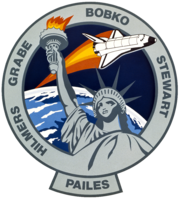STS-51-J
This article includes a list of references, related reading, or external links, but its sources remain unclear because it lacks inline citations. (May 2008) |
| COSPAR ID | 1985-092A |
|---|---|
| SATCAT no. | 16115 |
| End of mission | |

 | |
STS-51-J was a NASA Space Shuttle mission. It was the first flight of Space Shuttle Atlantis and the 21st shuttle mission overall. It launched from Kennedy Space Center, Florida, on 3 October 1985, carrying a payload for the U.S. Department of Defense, and landed four days later, on 7 October.
Crew
| Position | Astronaut | |
|---|---|---|
| Commander | Karol J. Bobko Third spaceflight | |
| Pilot | Ronald J. Grabe First spaceflight | |
| Mission Specialist 1 | David C. Hilmers First spaceflight | |
| Mission Specialist 2 | Robert L. Stewart Second spaceflight | |
| Payload Specialist | William A. Pailes, MSE Only spaceflight | |
Backup crew
| Position | Astronaut | |
|---|---|---|
| Payload Specialist | Michael Booen | |
Mission parameters
- Mass:
- Perigee: 295 miles (475 km)
- Apogee: 301 miles (484 km)
- Inclination: 28.5°
- Period: 94.2 min
Mission summary



STS-51-J launched on 3 October 1985, at 11:15 EDT, from launch pad 39A at the Kennedy Space Center. The launch was delayed by 22 minutes and 30 seconds due to a problem with a main engine liquid hydrogen prevalve close remote power controller; the controller was showing a faulty "on" indication.
The mission was the second shuttle flight totally dedicated to deploying a Department of Defense payload, after STS-51-C. Its cargo was classified, but it was reported that two (USA-11 and USA-12) DSCS-III (Defense Satellite Communications System) satellites were launched into stationary orbits by an Inertial Upper Stage. The DSCS satellites used X-band frequencies (8/7 GHz). Each DSCS-III satellite had a design life of ten years, although several of the DSCS satellites have far exceeded their design life expectancy and continue to operate effectively as of 2011.[citation needed]
The mission was deemed successful. After a flight lasting 4 days, 1 hour and 45 minutes, Atlantis landed on Runway 23 at Edwards Air Force Base at 13:00 EDT on 7 October 1985.
See also
- Spaceflight
- Space Shuttle program
- Space Shuttle Atlantis
- List of space shuttle missions
- List of human spaceflights chronologically
References
![]() This article incorporates public domain material from websites or documents of the National Aeronautics and Space Administration.
This article incorporates public domain material from websites or documents of the National Aeronautics and Space Administration.
- Day, Dwayne (2010). "A lighter shade of black: the (non) mystery of STS-51J". The Space Review. Retrieved 4 January 2010.
External links

